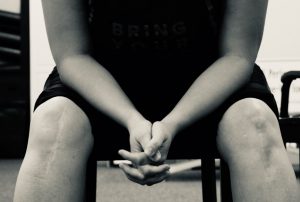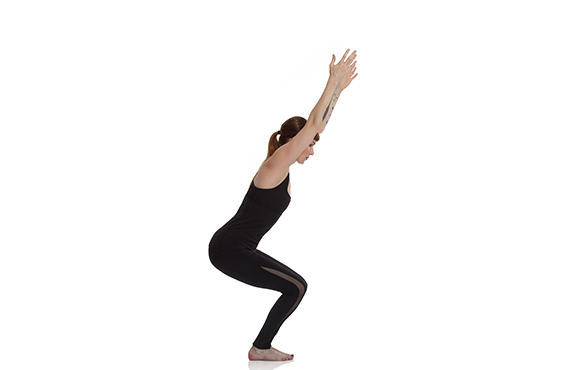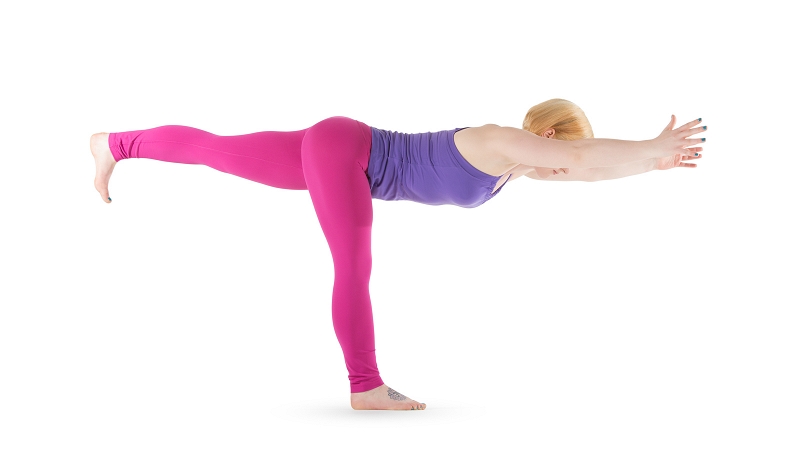A MUST Read for Athletes and Parents!
 I honestly have been looking forward to writing about ACL prevention because I have experienced everything ACL related. The picture above are my knees…gnarly, I know! I want to say it all stemmed from an ankle sprain in 6th grade, but that’s mainly speculation on my part. My freshman year of high school playing basketball I went down in a scrap trying to steal the ball, but ended up planting my foot down wrong and tore my right ACL. If any of you are previous athletes, you’ll understand what a devastation this was. I had been playing on the varsity team that year and thought everything was over. Thoughts like, “am I ever going to play basketball again?” and “how am I going to recover from this?” were swirling in my head. Luckily, my teenage melodramatic self did not get the best of me. I had surgery and started physical therapy right away. They took a graft from my right patella tendon to help repair the ACL. In less than 6 months I was back to sports and started playing basketball again. Three years later during my senior year, I ended up tearing my left ACL. Just thinking of that moment brings back the finality of it all. I was looking into playing at the collegiate level, but had to redirect that plan after what happened. I had “tweaked” my knee that winter during a hard planting and pivoting motion. At the time I just brushed it off, slapped a brace on my knee, and continued to play. Three weeks later during regionals, I took a long range 3 point shot that required extra oomph from my legs, came down on my knee wrong, and heard the dreaded “POP”. I knew right away what it was; I had felt this before. I never played basketball the way I used to after that. I was always super cautious and not as aggressive toward the hoop. Skip forward 8 years and a few extra pounds later. I was racing some kids in the park. Thinking I still had some speed in my feet, I went all out and once again, “SNAP”! I tore my right patella tendon (remember how I said that they took a graft from my right patella to fix my ACL? Yeah…that came back to bite me). I was literally just running in a straight line on some grass… JUST RUNNING!! What I didn’t realize at the time was that a). I did not warm up for this spur of the moment/back to my glory days sprint, b). I have not worked out or prepared my legs for a race like this since high school, and c). I’M NOT 18 ANYMORE!! The doctor asked me if I had a tendon degeneration disease because he had never seen a patella tendon snap completely in half like that. I assured him that I did not. Moral of the story here is once you tear one ACL you are more likely to reinjure it or injure the other side. In fact, according to John Hopkins Medicine “Studies have shown that once an athlete has torn his or her ACL, the chance of re-tearing it is six times greater. Additionally, once a female athlete has torn her ACL, she becomes 16 times more likely to tear her ACL in the other knee.”
I honestly have been looking forward to writing about ACL prevention because I have experienced everything ACL related. The picture above are my knees…gnarly, I know! I want to say it all stemmed from an ankle sprain in 6th grade, but that’s mainly speculation on my part. My freshman year of high school playing basketball I went down in a scrap trying to steal the ball, but ended up planting my foot down wrong and tore my right ACL. If any of you are previous athletes, you’ll understand what a devastation this was. I had been playing on the varsity team that year and thought everything was over. Thoughts like, “am I ever going to play basketball again?” and “how am I going to recover from this?” were swirling in my head. Luckily, my teenage melodramatic self did not get the best of me. I had surgery and started physical therapy right away. They took a graft from my right patella tendon to help repair the ACL. In less than 6 months I was back to sports and started playing basketball again. Three years later during my senior year, I ended up tearing my left ACL. Just thinking of that moment brings back the finality of it all. I was looking into playing at the collegiate level, but had to redirect that plan after what happened. I had “tweaked” my knee that winter during a hard planting and pivoting motion. At the time I just brushed it off, slapped a brace on my knee, and continued to play. Three weeks later during regionals, I took a long range 3 point shot that required extra oomph from my legs, came down on my knee wrong, and heard the dreaded “POP”. I knew right away what it was; I had felt this before. I never played basketball the way I used to after that. I was always super cautious and not as aggressive toward the hoop. Skip forward 8 years and a few extra pounds later. I was racing some kids in the park. Thinking I still had some speed in my feet, I went all out and once again, “SNAP”! I tore my right patella tendon (remember how I said that they took a graft from my right patella to fix my ACL? Yeah…that came back to bite me). I was literally just running in a straight line on some grass… JUST RUNNING!! What I didn’t realize at the time was that a). I did not warm up for this spur of the moment/back to my glory days sprint, b). I have not worked out or prepared my legs for a race like this since high school, and c). I’M NOT 18 ANYMORE!! The doctor asked me if I had a tendon degeneration disease because he had never seen a patella tendon snap completely in half like that. I assured him that I did not. Moral of the story here is once you tear one ACL you are more likely to reinjure it or injure the other side. In fact, according to John Hopkins Medicine “Studies have shown that once an athlete has torn his or her ACL, the chance of re-tearing it is six times greater. Additionally, once a female athlete has torn her ACL, she becomes 16 times more likely to tear her ACL in the other knee.”
Looking back on all of this, I now see how this could have been prevented. I was doing a lot of single plane lifting, stretching and running: bicep curls, squats, lunges, triceps pull downs, leg presses…the list goes on and on. I had strong muscles, but they were definitely not balanced. Many of my smaller stabilizer muscles were greatly neglected. Our body mechanics are not meant to move in one plane, so why do we often train in a single plane of motion? Working at PT-Connections has taught me one huge lesson: train your body in all planes of motion (sagittal, frontal, and transverse) to help build ALL muscles. Luckily, I discovered yoga again after tearing my right patella tendon. I quickly learned that yoga applies many principles that Chad and the other PT’s teach at our clinic. At first some of the movements irritated my knees so I had to learn to listen to my body and adjust as needed. One way to protect your knees before going into any pose is to draw in your muscle energy to your core and set your alignment up properly. Lifting your toes up toward your head can help engage this muscle energy.
 For instance, in chair pose before even going into it, make sure that your foundation is set: your feet should be 4-6 inches apart with your toes facing toward the top of your mat and the root of your second toes should be able to draw a line directly through the center of your heel. Four points of your foot should also be grounded down into your mat: the ball of your foot, the base of your pinky toe, and both outer points of your heel. Now, bring your muscle energy to your core by drawing your toes up toward your head. For some people this may cause a cramps, so you can also use your yoga block to play with muscle energy by placing it in between your shins (NOT IN BETWEEN YOUR KNEES) and holding it steady during the pose. Next, blossom your sit bones back – this motion is essentially…well…sticking out your bum. This is then counteracted by slightly rooting down your tail bone to set a neutral pelvis. Holding that, lengthen through the crown of your head and bring your shoulder blades down into your back. Finally, you’re ready to go into your pose! Inhale your arms up above your head and exhale to sit down into your chair position. Do not slack and let your body lose all of the work that we just did prior to the pose. Take three breaths in this pose – holding the pose but not your breath. When you’re ready to come out, inhale and straighten your legs to rise up, then exhale your arms to your side. If you want to see the difference of how your knees feel, just go into the pose without doing any of the prior work. Many people don’t feel centered or are allowing their body to compensate in creative ways to get deeper into the pose. For a full visual of this, go to this link https://www.youtube.com/watch?v=KuH-A1V3iiM
For instance, in chair pose before even going into it, make sure that your foundation is set: your feet should be 4-6 inches apart with your toes facing toward the top of your mat and the root of your second toes should be able to draw a line directly through the center of your heel. Four points of your foot should also be grounded down into your mat: the ball of your foot, the base of your pinky toe, and both outer points of your heel. Now, bring your muscle energy to your core by drawing your toes up toward your head. For some people this may cause a cramps, so you can also use your yoga block to play with muscle energy by placing it in between your shins (NOT IN BETWEEN YOUR KNEES) and holding it steady during the pose. Next, blossom your sit bones back – this motion is essentially…well…sticking out your bum. This is then counteracted by slightly rooting down your tail bone to set a neutral pelvis. Holding that, lengthen through the crown of your head and bring your shoulder blades down into your back. Finally, you’re ready to go into your pose! Inhale your arms up above your head and exhale to sit down into your chair position. Do not slack and let your body lose all of the work that we just did prior to the pose. Take three breaths in this pose – holding the pose but not your breath. When you’re ready to come out, inhale and straighten your legs to rise up, then exhale your arms to your side. If you want to see the difference of how your knees feel, just go into the pose without doing any of the prior work. Many people don’t feel centered or are allowing their body to compensate in creative ways to get deeper into the pose. For a full visual of this, go to this link https://www.youtube.com/watch?v=KuH-A1V3iiM
 Many people also focus on the major large muscles when training for sports, but can easily neglect the stabilizers which greatly influence the health of your ACL. Yoga often challenges the stabilizers with balancing poses. One great stabilizer pose is Virabhadrasana III (Warrior 3). Play with this pose in all three planes. You can add a twist, turn your toes in, turn your toes out, lean to the left or right. Get creative, but always make sure that your foundation is set first! Sam Squared Yoga can teach you how to do poses like this and more in a safe manner. For a full schedule, go here https://pt-connections.com/yoga-schedule/
Many people also focus on the major large muscles when training for sports, but can easily neglect the stabilizers which greatly influence the health of your ACL. Yoga often challenges the stabilizers with balancing poses. One great stabilizer pose is Virabhadrasana III (Warrior 3). Play with this pose in all three planes. You can add a twist, turn your toes in, turn your toes out, lean to the left or right. Get creative, but always make sure that your foundation is set first! Sam Squared Yoga can teach you how to do poses like this and more in a safe manner. For a full schedule, go here https://pt-connections.com/yoga-schedule/
Chad will also be hosting a free seminar on preventing ACL and knee injuries on 6/18/2019 from 5:00 – 6:00 pm at PT-Connections (inside of the Pueblo Athletic Club). Take it from someone who has experienced ACL/Knee injuries, this is something that you need to come to! He will show you simple screenings that you can do for you or for any athletes in your household. Be sure to RSVP by clicking HERE or call 719-565-6678 to save your seat.